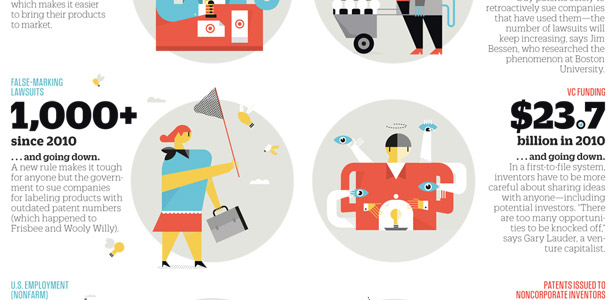Starting last fall and stretching through mid-2013, the U.S. has been overhauling the patent-approval process for the first time since 1952. The biggest change: our first-to-invent system, which favors creators, will become a first-to-file system, which favors . . . whoever files first. Uncle Sam says the reform will speed innovation. Our experts check the numbers.
NUMEROLOGY | The Real Cost Of Patent Reform 
Average patent wait time: 34 months . . . and going down. Startups that qualify for the new fast-track option get their patents reviewed in as little as 12 months, which makes it easier to bring their products to market.
False-marking lawsuits 1000+ since 2010 . . . and going down. A new rule makes it tough for anyone but the government to sue companies for labeling products with outdated patent numbers (which happened to Frisbee and Wooly Willy).
U.S. Employment (nonfarm): 131.7 million . . . and going up. If companies get patents more quickly, they can also start producing new products, which the White House says will generate jobs.
BAD FOR INNOVATIONLosses from "patent trolling" $80 billion per year . . . and going up. Because the new laws don't really crack down on patent trolls--those who buy patents solely to retroactively sue companies that have used them--the number of lawsuits will keep increasing, says Jim Bessen, who researched the phenomenon at Boston University.
VC Funding $23.7 billion in 2010 . . . and going down. In a first-to-file system, inventors have to be more careful about sharing ideas with anyone--including potential investors. "There are too many opportunities to be knocked off," says Gary Lauder, a venture capitalist.
Patents issued to noncorporate inventors 31,923 in 2010 . . . and going down. When Canada switched to a first-to-file system in 1989, the race to file intensified--and individual inventors were put at a disadvantage (compared to big firms with lots of resources). A similar scenario could play out here.
[Illustration by Romualdo Faura]
A version of this article appears in the February 2012 issue of Fast Company.
